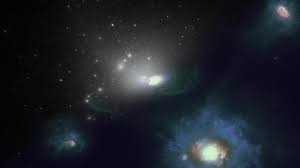Scientists may now see our galaxy in a whole new way thanks to neutrinos
Since ancient times, people have marveled at the huge array of stars, both brilliant and faint, that make up the Milky Way as they shine in the night sky above Earth. However, a brand-new approach is currently being used for the first time to examine our home galaxy. Scientists said on Thursday that they have created a picture of the Milky Way based on ghostly subatomic particles called neutrinos rather than electromagnetic radiation, or light. The first time these particles have been seen originating from our galaxy, they found high-energy neutrinos in pure ice buried deep under the surface of Antarctica. They then traced their source back to spots in the Milky Way.
This perspective is fundamentally different from what we can see with our own eyes or equipment that detects other electromagnetic sources, such as radio waves, microwaves, infrared, ultraviolet, X-rays, and gamma rays. The unexplained sources of neutrinos originating in the galaxy, maybe remains of spectacular star deaths known as supernovas, are what are being seen, not the stars, planets, and other objects that can be seen via their light.
Using more than 5,000 sensors spread over an area the size of a small mountain, the neutrinos were discovered during a ten-year period at the IceCube Neutrino Observatory at a U.S. scientific research facility near the South Pole.
“This observation is revolutionary. The galaxy was confirmed as a neutrino source. Every subsequent piece of study will make reference to this discovery, according to Georgia Tech physicist and IceCube team spokesman Ignacio Taboada.
“It came as a bit of a surprise to us that we did not identify a flux that originated in the close sources of our own galaxy when we found neutrinos of cosmic origin in 2013. The sky was meant to be dominated by galactic sources, as they do in all lightwavelengths. It took us ten years to find our own galaxy, according to Francis Halzen, an IceCube principal scientist from the University of Wisconsin.
The term “ghost particle” refers to neutrinos since they are electrically inert, unaffected by even the strongest magnetic field, and seldom interact with matter. Neutrinos pass through stuff, including stars, planets, and humans for that matter, unhindered as they go across space.
Neutrinos can pass through anything, even the whole planet Earth, just as light passes through glass without halting, according to Taboada.
“The neutrino is an elementary particle, which means that it is not composed of any smaller particles. They are produced during nuclear processes, but unlike electrons and quarks, they are not the fundamental units of matter. They are also produced when protons and (atomic) nuclei meet at very high energies, according to Drexel University physicist Naoko Kurahashi Neilson, who was a member of the study team that published their results in the journal Science.
It is impossible to fully understand the cosmos with just light. Similar to how the discovery of gravitational waves, which were disclosed in 2016, opened another new area, the capacity to employ particles like neutrinos in astronomy permits a more thorough analysis. The name of this discipline is “multi-messenger astrophysics.”
The highest-energy particles yet recorded, cosmic rays, are created by the same sources as neutrinos, but they are distinct in a crucial way. As electrically charged particles, cosmic rays can’t be directly tracked to their origin because the powerful magnetic fields of space change their course. Neutrinos travel in a path that returns them to their original source.
To identify neutrinos from other sources from those coming from our galaxy, the researchers used machine learning. They published a picture of their results that showed how neutrinos from the Milky Way, which are concentrated heavily near the galaxy’s centre, are represented by light.
There is controversy about the neutrinos’ point of origin. The evidence was in favor of a widespread neutrino emission in the Milky Way, although these particles may originate from particular, as of yet unidentified sources.
“At this point, the crucial question is. Only cosmic ray-producing sources are the source of neutrinos. They are cosmic ray source tracers. Where these cosmic rays come from is the crucial issue, according to Halzen.
The remnants of previous supernova explosions are “the most likely source of neutrinos and cosmic rays in our galaxy,” Taboada said. But thus far, this hasn’t been verified.







